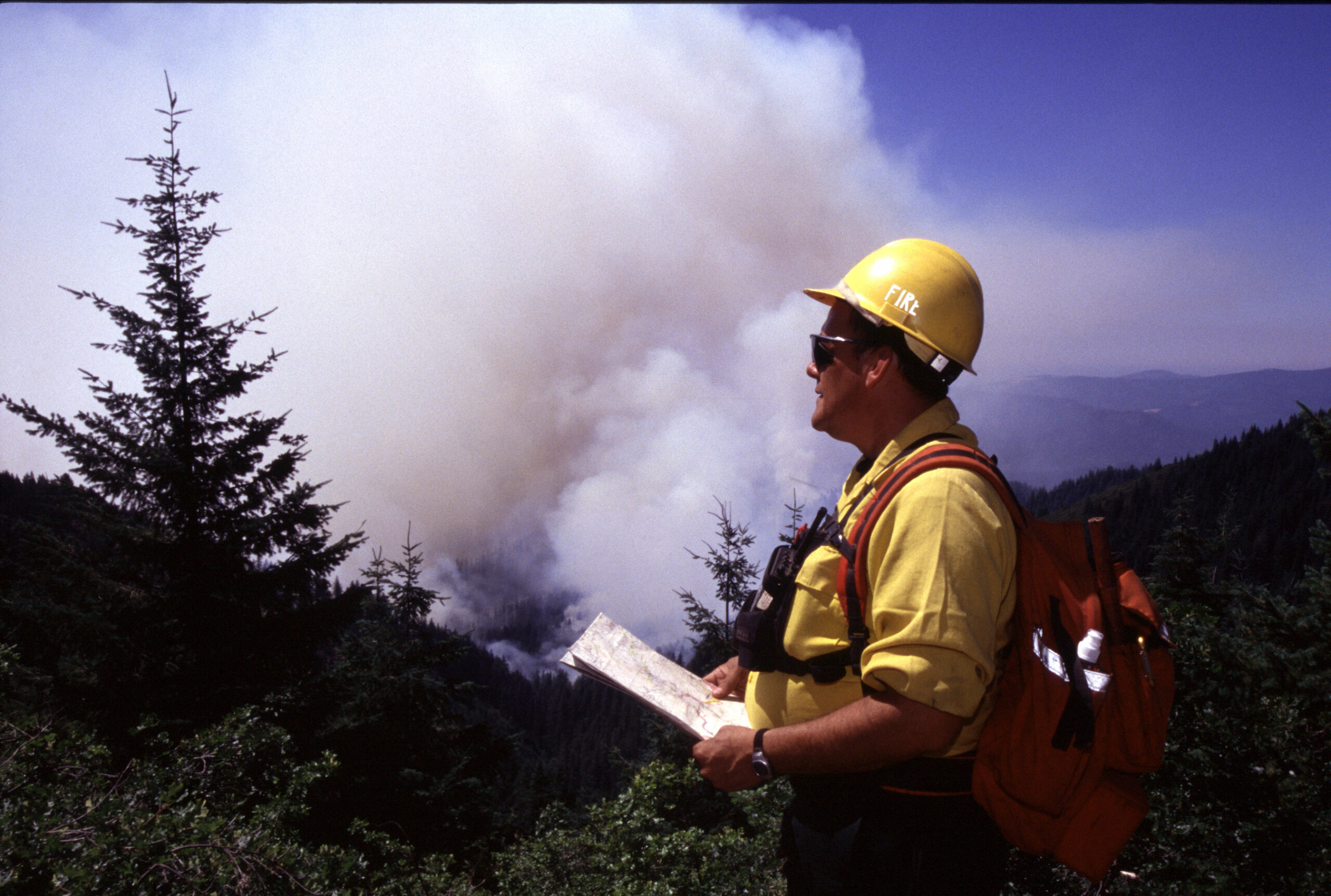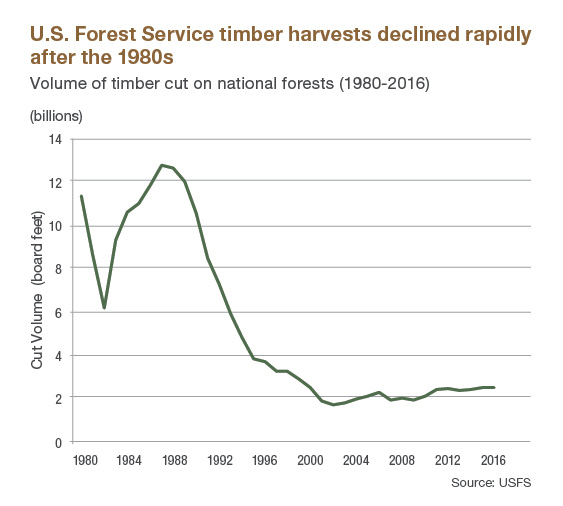At the end of the 19th century, a question loomed over our nation’s forests: Would there be enough wood and water to satisfy an expanding country? There were growing concerns that the nation’s forests were being rapidly depleted and that their ability to serve as a repository for water and other important values was diminishing as well. In 1905, when Congress created the U.S. Forest Service, the intent was to manage these public forests through a government bureaucracy as part of a broader federal public land system.
Over the years, there have been various suggestions of ways to reform the Forest Service, and in particular how to improve efficiency within the context of government ownership and management. More recently, alternative approaches that might involve substantially less control by the federal government have been put forth. The factors driving these suggestions of alternative management and ownership arrangements include competing demands by various constituent groups, battles between commercial and environmental interests, and general concerns about efficiency. Some of the proposals would attempt to reform the Forest Service from within, while others would involve changes in ownership, market decisions, and the fundamental control by the federal government. But in every case, the proposals reflect a desire and appetite for change.
Innovative Approaches
The early organizational structure of the Forest Service was formed within the context of what we now call the Progressive Era. The dominant view at the time was that government technocrats using scientific approaches would know how to best manage resources, including forests. The Forest Service was created to allow for scientific management of national forest lands. At that time, however, management was light, and harvesting levels were low. Economist Marion Clawson has characterized this early period from the creation of the Forest Service until World War II as one of custodial management, whereby the agency emphasized basic forest protection, including minimal fire protection.
This was followed by an era of intensive forest management from the late 1950s to the late 1980s. Concurrently, beginning in the late 1970s, a period that Clawson called “consultation and confrontation” also began and gave rise to the “timber wars,” which were characterized by battles between the timber industry and environmentalists over harvest levels and management practices. Ultimately, environmentalists won the timber wars. Timber harvests on public lands fell from about 12 billion board feet in 1989 to 2 billion board feet in 2000. The early 1990s brought about an era of ecosystem management, marked by a transition away from timber production toward a focus on forest conditions. While the prior goal had been to manage forests to be a golden goose that laid as many eggs as possible, the ecosystem-management approach was to manage the goose to look good—to make its plumage appear pristine—with little regard for egg production.
Along the way, the Forest Service has faced a number of important critiques of its management. Some, like Clawson’s, were not much concerned about the government owning national forests but wanted to see it manage them more effectively, particularly when it came to timber production. Clawson was concerned about how unproductive the agency had been despite the substantial investments made by the government, and he noted the higher productivity of private forest lands. Other economists, like John Krutilla, had a positive view of government ownership and valued environmental outputs over commodities. Krutilla’s goal was to improve management by providing a vehicle to optimize the joint value of the forest outputs—both commodity and non-commodity, including environmental and ecological outputs. He suggested that the national forest system should be viewed as a multiproduct firm, with the values of the outputs determined by both the market and also by techniques developed to value non-market outputs. Beginning in the 1970s, new legislation required the Forest Service to take management planning and non-commodity output production seriously. It developed a number of forest-planning models that focused on timber output but placed environmental constraints on that output.
Other analysts, however, have been less concerned with management per se and more focused on forest ownership and incentives, including market incentives. John Baden and Richard Stroup, for example, were among the first to challenge the notion that the federal government should own such large areas of U.S. forests and to question the incentives faced by government managers. They argued that markets and the signals they provide should receive more attention. Moreover, they challenged the idea that public ownership would efficiently provide the correct level and mix of outputs. Baden and Stroup argued that the market would do better and favored privatizing the forests. The Sagebrush Rebellion, also of that era, called for the federal government to transfer the ownership of national forests and other public lands to the states. Indeed, the ideas of decentralization and privatization appear to have peaked during the Reagan administration.
Still others have suggested that external forces should guide forest management. Randal O’Toole has argued that the crucial distinction is not who owns the land but what system of governance guides land managers. He suggests that federal land managers should charge fair-market values for all resources and outputs and should be funded exclusively out of the receipts they collect. In addition, O’Toole argues that federal lands should be turned into fiduciary trusts, which have legal obligations that would fundamentally change the incentives facing land managers. O’Toole is not the only one to propose these changes. Others arguing for trusts include Sally Fairfax of the University of California, Berkeley, who developed outlines for state forest trusts. Such a model would shift management from the federal agency to various trusts that would allow for greater management flexibility.
Robert Nelson has argued for more decentralized decision-making for national forests through a variety of mechanisms, including privatizing or shifting control to states, as well as a number of alternative management arrangements. For example, in a recent publication from PERC, Nelson proposed a charter forest system, in which land ownership would be retained by the federal government but management would be freed from the rigidities and other bureaucratic constraints that have plagued Forest Service managers in the past. Management goals could be set within the context of tight environmental regulations. Other approaches include various models to shift power from the agency to other decision-making entities that would generally have greater flexibility and autonomy.
The Next Chapter
What will be the future mission of the Forest Service? Traditionally, national forests have provided industrial wood, water, wildlife habitat, and general environmental services. Recently, in response to concerns over climate change, other “uses” have emerged, such as the role of forests in capturing and storing carbon dioxide. As discussed above, in the post-war period, the Forest Service had primarily focused on wood production. But this emphasis has declined over the subsequent decades, and other uses and values have gradually developed in response to new constituencies. However, these constituencies often provide little support to the Forest Service and its budget.
Is there a new mission for the Forest Service? If so, what is the appropriate ownership, what are its goals and objectives, and how should it be managed? And do any of the current proposals offer a viable alternative?
Ever since timber production declined, the Forest Service has struggled to find an acceptable mission. An overarching problem is that without timber revenue, the agency has had a harder time securing funding. As a government agency now almost entirely reliant on Congress for funding, the Forest Service finds itself in an undesirable situation.
To face this new reality, the Forest Service likely needs a new and clear mission. One option could be a return to the custodial management of the pre-World War II era. Alternatively, the agency could focus on providing recreational amenities. A third option might be to support wildlife, biodiversity, and the maintenance of ecological systems. These are arguably good choices, but in many cases it would result in a Forest Service mission that is almost identical to that of the National Park Service. With the dramatic reduction of timber harvesting that has already occurred, however, few may contend against this outcome.
One mission that has been thrust upon the Forest Service is firefighting. With the growing incidence of wildfires in national forests in recent years, the agency has been forced to devote more and more resources to fire suppression. Congress, however, has not appropriated new funds for this purpose, so funds have been drawn from other parts of the Forest Service’s budget. Moreover, there is no clear consensus about how much the Forest Service should do to reduce wildfires. In California, local environmentalists have called for remedial actions to reduce fuels in national forests—for instance, by thinning or removing dead or dying trees that increase the chances of wildfire. Yet other national environmental groups insisted that the forest be left relatively untouched, with no fire-reducing activities. More generally, a growing group of environmentalists argues against fire control since they do not consider it part of the “natural system.” Indeed, science supports the reduced fire suppression up to a point, since there are forest types that require fire to regenerate successfully. But where is the line?
Finally, there is the question of climate change. Forests contain vast stores of carbon. Indeed, in the United States, forest growth offsets 13 percent of total U.S. carbon emissions. Obviously, national forests play a large role in managing carbon, and the Forest Service’s management decisions will have significant effects on emission offsets, or lack thereof.
Scope for Change
The Forest Service was created primarily to promote continuous water flows and to ensure adequate timber availability. Thus, it was viewed as a producing agency and therefore assigned to the Department of Agriculture rather than the Department of the Interior. Over the years, some groups have expressed strong sentiments for nationalizing most of the nation’s private forests, presumably into the National Forest System. They argued that the forests were largely nonrenewable and that the private system would not incur the costs of reforestation. Toward the middle of the 20th century, however, the evidence on reforestation became much clearer. It became apparent that private-sector forests were thriving, and many of them had been substantially reforested. In fact, it was the Forest Service that was roundly criticized for inadequate management and regeneration, and it is these criticisms that have led to subsequent proposals for different ownership or administration systems that would generate better results on national forests.
Although certain incremental management adaptations may be feasible, the Forest Service has resisted fundamental change. In particular, the agency has been reluctant to give up its management prerogatives. Although the Forest Service meets with local interests during its planning process, it has insisted that final decisions remain with the agency and its political masters. Similarly, the agency has resisted turning some forests over to state control, even if only for management, as proposed during the Sagebrush Rebellion. Notably, it has also resisted relying more on markets to decide how it should manage its forests. Even to this day, targeted harvest levels are determined administratively in response to political pressures, with little consideration of market conditions.
The Political Environment
It is difficult to imagine the political process supporting significant changes in the Forest Service within its current institutional structure. Periodically, there have been discussions about relocating the agency into the Department of the Interior, but such proposals have been strongly resisted within the Forest Service as well as externally. Internally, such proposals are resisted because the agency enjoys a great deal of autonomy within the Department of Agriculture. Similarly, for most outside interests, there is little gain from undertaking a battle that would be associated with such major institutional or locational changes in the Forest Service. Moreover, since environmentalists have won the timber wars, the contentiousness between the timber industry and other interests has largely disappeared—timber production from national forests is now so low that most of the industry has lost interest in harvesting timber on federal lands.
Although there have been many suggestions for major changes in the management, administrative structure, and ownership of national forests, few of these suggestions have been acted upon in any significant way. Some of these alternative arrangements could undoubtedly improve facets of the overall efficiency of the Forest Service. However, most of these proposed changes are unlikely to occur at this time. Currently, the agency receives relatively little criticism. The contentiousness of the timber wars have largely died down. And since timber harvest levels have rapidly declined, as have the harvests of old-growth forests—a source of immense conflict in the earlier era—national forest issues do not capture the headlines as much as they once did.
Today, the Forest Service might reasonably be viewed as an agency with two main purposes: maintaining biodiversity and serving as a wildfire-fighting organization. There are also concerns about the role these forests may play in sequestering—or, in the case of wildfire, releasing—carbon. Moreover, there are concerns about the agency’s budget, and in particular the question of adequate funding for firefighting, which is currently creating funding shortfalls for many traditional national forest programs. One result of these changes has been a de facto remaking of the Forest Service’s mission. With the decline in timber production on national forests, the major function of the Forest Service in the future could become tourism, habitat maintenance, and wildfire control. This is the direction the Forest Service has moved in recent years.







